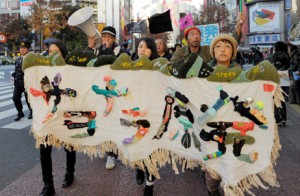Un anno doipo Fukushima: uno striscione con su bambole che nei caratteri giapponesi significano “Addio nucleare”. E’ il banner della manifestazione che nel centro di Tokyo si è appena tenuta a Shibuja. Da Asahi Shimbun del 10.3.12:
Asahi Shimbun
Anti-nuclear protests take on a ‘hyper-cute’ look
Satoko Miyakoshi knew nothing about nuclear power before the March 11 disaster so she decided to attend an anti-nuclear demonstration in the Koenji district of Tokyo on April 10 to learn more about the issue.
She left the event frightened. Not necessarily about cesium, but by what went on at the demonstration, where loud speakers blared out anti-nuclear slogans.
“Some placards were, like, in bloody letters,” the 30-year-old designer said. “I believe there were many people out there, not just myself, who were undecided whether to join. It seemed to me that radicals were leading the event. It was not mass-friendly.”
Miyakoshi is now one of the key figures behind a new type of demonstration that is attracting passers-by who find the protests “cute.”
These “street expressions” are not organized by labor unions. They are also not an offspring of sound-blasting demonstrations, an alternative form of protest that emerged in the 2000s.
The new rallies are created by a third generation of demonstrators, most of them young.
One was held in Tokyo’s Shibuya district on Dec. 17. A long file of demonstrators, many of them in their 20s and 30s, marched along the Center-gai shopping street. No sound truck, with dance music pouring out of the loudspeakers, led the procession. Instead, the march was led by women carrying a banner.
Anti-nuclear messages in light colors dotted the placards and triangular banners.
“What group are you from?” asked a female passer-by, apparently a high school student, who reached out for a triangular banner.
“We are not from a group,” a participant answered. “We are volunteers who got together through Twitter.”
Mothers pushing baby strollers formed a group near the end of the procession, followed by trash collectors carrying transparent plastic bags.
“We want to prevent the spread of the negative reputation that demonstrators have bad manners,” one of them said.
This “Twitter Demonstration” was organized by TwitNoNukes. The Dec. 17 march was the seventh in the series of the nearly monthly event, which first convened on April 30 following the accident at the Fukushima No. 1 nuclear power plant triggered by the March 11 Great East Japan Earthquake and tsunami.
About 1,000 people have participated each time.
On closer look, the symbolic banner consists of dolls sewn together to form letters that read “Sayonara Genpatsu” (Goodbye to nuclear plants). The palm-sized pamphlets (“zines”) and comics have been described by walk-in participants as “hyper-cute.”
Those props were created by Sayonara Atom, a group of about 20 artists including Miyakoshi.
Two people involved in initiating the Twitter Demonstrations are a company employee who goes by the Twitter name of @bcxxx and Taichi Hirano, a 26-year-old nursing-care worker. They asked, “Why is there no demonstration centered on a single issue (of opposing nuclear power) that is neither of the sound-blasting type nor involves political parties and organizations?”
Sayonara Atom, which has pitched in since July, has contributed greatly to creating the impression of a soft and cute demonstration.
In addition, a friend of @bcxxx, who shares a passion for hardcore punk music, also created T-shirts using a favorite font of hardcore punk bands. The T-shirts are on sale during demonstrations and online.
In December, TwitNoNukes edited and published a book titled “Demo Iko!” (Let’s go to demonstrations!) from Kawade Shobo Shinsha Publishers, a major publishing house in Tokyo.
In an opening article, writer Kureichi Matsuzawa argued that demonstrations are a form of expression, much like in films, music and newspapers.
Opposition to the war in Iraq prompted a series of sound-blasting demonstrations, which gained power since around 2003, as if to fill the empty space left by “orthodox” demonstrations that used to be organized by labor unions and other groups.
These protests featured sound trucks carrying music bands and disc jockeys, and attracted young music aficionados. However, police intensified their crackdowns, and more than 10 demonstrators were arrested in September.
“I initially found it fun to be part of a sound-blasting demonstration,” said space producer Ryo Takenaka, a central member of the Twitter Demonstration. “But nuclear power is all about your life. It shouldn’t just be about festivity.”
“We are not criticizing sound-blasting demonstrations,” said Miyakoshi. “We want to make an offensive on a quite new front.”
The Twitter Demonstration touts itself as being “moderate,” but its strategies are thought-out.
“Sound-blasting demonstrations tend to set free a punk mentality, in a negative sense of the word, including provoking the police,” @bcxxx said. “They gave the wrong preconception that you risk being arrested if you go and join a demonstration. We are creating infrastructure for demonstrations, which requires nothing more than just e-mail lists for staff members, announcements on Twitter and online printing (downloading placards at convenience stores).”
Four demonstrations have already taken place in Kobe under the same formula. Similar events are planned in Fukuoka and Hamamatsu, Shizuoka Prefecture.


